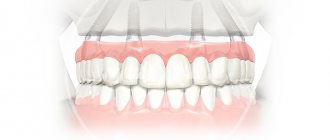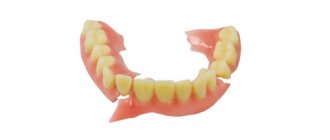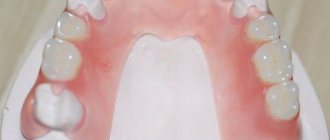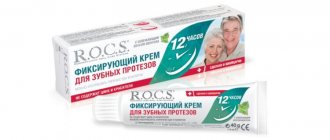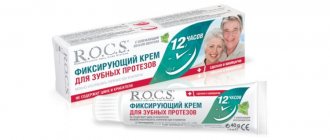Removable dental bridges and dentures are in great demand due to their affordable cost. Removable dentures are used for complete or partial loss of teeth, as well as as a temporary solution until a fixed structure is installed.
It should be noted that modern prosthetics are very different from the bulky and uncomfortable products of the last century. Now they look more aesthetically pleasing, have a natural appearance, fit tightly to the gums and are securely fixed.
Indications for removable prosthetics can also be inflammation of the gums, bone deficiency, or contraindications to the installation of dental implants.
Installation Features
Removable structures have a base that imitates natural gums. Therefore, they look natural, like natural teeth.
In case of complete edentia, the removable denture is attached directly to the gums. The prosthesis fits tightly to the soft tissues, without displacement or loosening.
The prosthesis is fixed using clasps, hooks or implants. The lower part is attached to the roots of the natural teeth, and the upper part is attached inside the base of the structure. If the prosthesis replaces the entire dentition, then fixation occurs only on the gums.
Clasp prosthesis: characteristics, nuances of operation
Clasp dentures are recognized by experts as the best option for restoring lost teeth with partial dentures, since the structures have a number of significant advantages over other types of dentures:
- The denture has good rigidity, ensuring uniform distribution of the load when eating food between the teeth and soft tissues of the oral cavity. Installing a clasp will eliminate the risk of bone tissue atrophy;
- The structure is fixed in the oral cavity with the help of special clasps, which remain completely invisible to prying eyes;
- The clasp process has a compact size, which facilitates and simplifies the process of getting used to it. The use of this type of design eliminates the risk of such negative reactions as the occurrence of a gag reflex, stomatitis, and impaired speech articulation;
- The product is held as firmly as possible in the oral cavity;
- Clasps are applicable in the most difficult clinical cases and can be used for periodontitis. The product will prevent further loosening of the teeth;
- The product has high strength and resistance to mechanical loads and environmental factors.
Clasp dentures have their own classification into types according to the type of fastening. The simplest option is products with clasps. They are quickly manufactured, the process of fixing them is also not associated with significant difficulties, and are cheaper than other types of clasps. However, such a prosthesis cannot be recommended for installation in the smile area - the clasps can be clearly visible in the oral cavity.
If a high level of aesthetics is required from the design, you should choose clasps with attachments or special telescopic crowns. These types of fastenings are invisible, but the price of the product will be significantly higher, and in addition, installing clasps on attachments requires pre-preparation of a decent number of healthy teeth.
Types of removable dentures
Dentures for complete absence of teeth
These removable dentures are a lightweight, curved plastic plate that covers the entire jaw and palate (if used on the upper jaw). Artificial teeth (made of plastic or porcelain) are attached to it. The removable bridge is fixed due to the natural suction effect of the gums. The use of removable structures is possible only in the case of complete edentia (loss of all teeth).
Conditionally removable orthopedic prostheses
Such removable dentures can be used in case of loss of single teeth (for example, chewing teeth) or in case of significant violations of the integrity of the dentition (loss of a group of teeth). These orthopedic elements can also act as temporary structures. To fix them on natural teeth, special locks (clasps) are used. The component is made of durable metal, which ensures its reliable installation.
It is important to understand that not all partial denture materials are suitable for restoring teeth in the smile area. Therefore, in the case of restoration of the front teeth, it is better to choose removable dentures on implants.
Lamellar
This type of plate dentures is most often used in cases of loss of chewing teeth. This is one of the simplest and most affordable removable dentures.
Removable sectors or segments.
They are unilateral partially removable dentures used when several chewing teeth are lost in a row on one side of the jaw.
Immediate dentures
This is a temporary structure. This product is designed to hold adjacent teeth in place and protect gums until a permanent denture or crown is fabricated. Externally, an immediate denture looks like an ordinary tooth, but on the sides it has special clippers in the form of wings, with the help of which it is secured to the gum. Thanks to these fastenings, it received its second name - “butterfly”
Fixing powder
It is made from sodium alginate, which contains natural substances that are biologically compatible with living gum tissue. The principle of using the powder is the same as that of a cream or fixing pad. A small amount of fixing powder is applied to the previously cleaned denture, the device is immediately put on the teeth and bonding occurs. Fixing powder, unlike fixing creams or pads, is usually available without aromatic or flavoring additives.
Modern materials
Removable acrylic dentures
Budget option based on polymers. Conventional plastic dentures strongly rub the gums and do not fit well. However, our laboratory specialists use a special formula - a new generation acrylic prosthesis, with the addition of crushed diamond chips. The design is more resistant to chewing loads, comfortable to wear and has an aesthetic appearance, and also provides a longer service life.
Elastic
These can be soft nylon or thin removable dentures made of acrylic resins (Acry Free). The material adheres tightly to the gum tissue in the oral cavity. Does not cause pain or discomfort. Can be used for bruxism.
Who is suitable for nylon prostheses?
The use of removable nylon dentures is acceptable in the absence of one or several teeth. The products are used in cases of lack of extreme, lateral or front teeth in a row and even in cases of complete edentia. Edentia is commonly understood as the absence of all teeth in a row or jaw. The use of removable dentures made of nylon is possible for sensitive and weak gums, as well as for restoring dentition in children. Such orthopedic products do not contain metal compounds and are excellent for patients with allergic reactions. As for nylon itself, it is absolutely hypoallergenic.
With locks (sandwich dentures)
Installation requires two healthy tooth roots. One part of the lock is attached to the dental bridge, the second (abutment) is fixed in the root of the tooth. The prosthesis does not have a septum in the palate, which ensures maximum taste sensitivity. Thanks to the partial overlap, the removable denture can be worn for several days, only being removed for cleaning.
Dentures on implants
The most popular type of prosthesis. It is securely attached to the gum due to four supports connected to each other by a beam. Removable dentures on implants provide an even load on the jawbone, and the absence of a palate in the structure guarantees a natural taste perception when eating. It is easy to use, has a long service life and can be easily replaced with a new one if necessary. The only drawback is the high cost of installation due to the materials used. However, the price is fully justified by the quality, comfort and durability of the product.
Clasp dentures
This type of prosthesis is suitable for complete and partial restorations. Due to its aesthetics and affordable price, removable clasp dentures are in high demand among patients in dental clinics.
When making a removable clasp denture, specialists use a base made of elastic plastic, to which a metal beam is attached. Dental crowns made of artificial materials are fixed on the latter. Depending on the type of structure and the wishes of the patient, crowns on a dental bridge can be made of plastic, metal or metal-ceramics.
A partially removable denture is attached using clasp hooks if there are native supporting teeth. Or it could be a hidden mechanism that connects the crown to the base of the tooth. The clasp bridge is easy to use - it does not need to be removed before going to bed.
Fixed dentures on implants
Classic implantation. This method of restoring teeth in the absence of teeth makes it possible to reproduce functionally and aesthetically natural teeth as closely as possible.
This procedure occurs in 2 stages. During the first stage, implants are installed. The second stage is carried out after about 3 - 6 months - the time for the implants to engraft into the bone. The second stage is the installation of dentures on implants. Single crowns (more expensive) or bridge structures (cheaper) can be used as prostheses. These dentures are similar to conventional ceramic ones; they are simply installed on implants.
The frame material of the structure can be an alloy of chromium and cobalt or the more expensive zirconium dioxide. And for patients with allergies to metals, zirconium dioxide is the only option for implant prosthetics.
The use of such prostheses is comfortable, does not cover the gums and palate, and does not require getting used to. They are also more aesthetically pleasing and do not attract the attention of others.
Advantages: durability, lightness of construction, preservation of taste sensations, absence of a gag reflex, complete uniform chewing, and restoration of dental function by 90%.
The disadvantages are high cost, duration of treatment, and sometimes the need for bone grafting.
Fastening methods
For complete restoration of the dentition, a spherical or beam method of fastening is used. The first method is used only for fixing 1-2 implants, due to the mobility of the fasteners. A removable denture on a bar provides a strong and reliable fastening of the structure in the mouth. Does not move when talking or eating. Due to the high precision of installation, the patient’s natural bite is restored.
There is a third, screw method: A removable denture is attached directly to implants installed in the bone tissue. Advantages of the method: maximum accuracy of installation, uniform distribution of load on the jaw, high aesthetics.
Fixed crowns and bridges
Two methods can be used to install single crowns or bridge structures:
- For cement. Traditionally, dental prostheses are fixed using a hardening mass. This is a special dental cement that, after hardening, reliably connects the crown and the supporting part.
- On the screw. This method is used only when installing a crown on an implant, along with cement fixation. The screw is inserted into the abutment through the hole in the prosthesis and tightened using a special key.
Fitting and installation
The installation process will take only 2-3 days, and will require 3 visits to the doctor.
The initial stage includes a primary diagnosis of the oral cavity, the condition of the teeth and gums, as well as taking an impression. The production of a removable denture will take from 3 to 14 days, depending on the type of design chosen.
At the stage of installing a removable denture, it is important to assess the level of comfort when wearing it. It is important that the patient does not experience pain during fitting and does not rub the gums.
At the final stage, the doctor secures the prosthesis with clasps and tells the patient how to use and care for it.
In the case of implants with bar fasteners, support rods are first fixed in the jaw tissue. A short break will be required for implantation. After this, a completely removable denture is installed.
If the patient does not have the opportunity to undergo a rehabilitation period, an alternative may be implantation technology with immediate loading. In this case, tooth restoration takes 1-2 days.
With proper use, a removable denture will last you 7-10 years. If damage occurs, it can be repaired, but if the base is damaged or the dental crowns are severely deformed, then our experts recommend replacing the denture with a new one to eliminate the risk of injury to the oral cavity and infection.
Nylon prostheses: performance, disadvantages, advantages
Advertising of some clinics presents nylon prostheses to consumers as a more comfortable, practical and modern alternative to acrylic products, but is this really so?
If you start to understand in detail, you can find out that nylon prostheses have a number of very significant disadvantages:
- The products are characterized by high elasticity and softness, eliminating the qualitative distribution of the load that occurs when eating food. This entails an acceleration in the rate of thinning of bone tissue and subsidence of the gums. Due to the subsidence of the gum, its relief will gradually change and this leads to the fact that the prosthesis no longer fits tightly to it, which means it will not stay securely in the oral cavity;
- Prosthesis clasps are also made from nylon, so they cannot
firmly fix the structure on the supporting teeth; The denture is also loosely attached to the soft tissues of the mouth, which increases the risk of it falling out.
However, not everything is so bad; nylon prostheses also have advantages that make them a fairly popular type of prosthetic product for patients. They are soft and do not cause discomfort during use, so the process of getting used to them goes much faster. Nylon dentures are compact and light weight; due to these properties, their installation rarely causes problems with diction.
Products made from nylon are more aesthetically pleasing than acrylic dentures; they are visually invisible in the oral cavity. The use of nylon prostheses is not associated with a high risk of allergic reactions, since this material has high biocompatibility with natural tissues of the human body.
Advantages of removable dentures
Installing a denture helps restore the aesthetics of the dentition. However, this is not its main function. Missing teeth leads to a number of problems: poor digestion, displacement of existing teeth, asymmetry of the facial muscles and difficulties with diction.
Removable prosthetics is an affordable method that helps solve the problem of complete or partial edentia.
Modern dentures are hypoallergenic and safe. High-quality materials allow us to develop durable structures with strong fixation in the oral cavity.
Prosthetics with acrylic dentures: features, pros, cons
Acrylic structures can be called a classic option for prosthetics, since they have been used in dentistry for quite a long time. Despite the emergence of other types of prostheses, acrylic prostheses remain a fairly popular option among patients. The demand for structures does not fall due to their qualities such as: budget price, long useful life, ease of production and installation.
The fastening element of the product are specialized hooks (clasps), which can be made from either plastic or metal alloy. The total cost of the prosthesis will depend on the type of clasps. For example, the hooks of the product can be made from an alloy of gold and platinum: such a design will cost more than a prosthesis with locking elements made of ordinary metal.
Acrylic structures are traditionally used for the restoration of distant masticatory units. In this case, it will be impossible to use another type of prosthesis, since there is a lack of teeth that can act as a support for fixing the product. It is also advisable to install acrylic dentures under the following circumstances:
- If the condition of the teeth is poor and does not allow the installation of a prosthetic bridge. Acrylic dentures can help patients with periodontitis, which causes loose teeth. It will be impossible to install a bridge on loose teeth;
- If diagnostics have revealed the impossibility of implantation or installation of other types of prosthetic products. While there are a sufficient number of advantages and the possibility of application in various clinical cases, acrylic prostheses also have a number of disadvantages, including:
- Considerable massiveness of the structure. The prosthesis will cover a significant area of the palate, which will negatively affect the functioning of taste buds and can lead to impaired diction. The massiveness of the prosthesis makes the process of adaptation to it lengthy;
- Low aesthetics. The clasps of the product are clearly visible;
- Acrylic is a material with a high degree of density and rigidity, and therefore the patient may feel discomfort when using the prosthesis;
- Acrylic dentures do not provide the required strength of fixation in the oral cavity, especially if prosthetics are performed in the lower jaw area. When wearing the product on the lower dentition, it is recommended to strengthen the strength of its fastening by using special fixing creams and gels;
- The prosthesis is sensitive to mechanical stress and can easily crack;
- Acrylic is a porous material that can actively accumulate plaque, and pigments, penetrating into the layers of the structure, can change its color.
Another disadvantage of acrylic products is the risk of allergies. Acrylic polymer is an allergenic type of plastic, so before installing products made from it in the oral cavity, you should make sure that the patient does not have an individual intolerance to this type of polymer.
Care
Cleaning a removable denture is not much different from cleaning natural teeth. Although it has its own characteristics.
After each meal, it is recommended to rinse them thoroughly with water. This will prevent bacteria and infection from entering the gums.
It is better to clean it with professional products suitable for its material. If the structure is completely removable, it is recommended to leave it in a disinfectant solution before going to bed.
Periodically check the denture for cracks and chips. If any damage is found, consult a doctor immediately.
For preventive purposes, it is important to visit the dentist at least once every six months. The specialist will conduct a professional examination, check the condition of the jaw and gum tissue, and also clean the dental bridge from contamination.
ACRI-FRI - prostheses that do not break
ACRI-FRI is the latest material for removable denture bases, high strength.
Denture bases are made by injection molding from acrylic resin. Does not contain polymethyl methacrylate or methyl methacrylate.
- Increased strength characteristics (do not break)
- Possibility of use for any dental defects
- Excellent reproduction of the relief of the oral cavity
- High hygiene due to extremely low water absorption and non-survival of microorganisms
- Long service life
- Fits exactly, does not deform
- Does not cause allergies
Prostheses made from the latest VERTEX (see picture) have long been loved by our patients, whose comfort cannot be compared with any acrylic plate prosthesis.
VERTEX is the latest hot polymerization plastic, high strength with the addition of silicone for the manufacture of partial, complete removable dentures, as well as for complete dentures supported by implants.
To increase comfort and quick adaptation, a soft silicone gasket with a long shelf life made of VERTEX SOFT material is used. Its advantages:
- Does not absorb odors
- Doesn't peel off
- Polymerizes together with the prosthesis base
Alternative solutions
Atrophy of the jaw tissue becomes a serious argument in favor of fixed prosthetics. In the case of complete adentia due to bone deficiency, the optimal solution is immediate implantation, with fixation of the prosthesis for 2-3 days.
This technology includes All-on-4 and All-on-6 punctures. For installation, 4 and 6 dental implants are used, depending on the condition of the bone tissue. This technology allows you to fix a removable denture immediately after installing the implants.
Titanium rods are almost completely fused with the jaw bone. The prosthesis is tightly fixed to the implants, without the risk of displacement, and it can be loaded immediately after its installation.
The operation includes several stages:
- Initial examination, hardware diagnostics using 3D modeling technology.
- Preparing the jaw for implantation - removing decayed teeth, choosing a site for installing implants.
- Fixation of titanium rods in a gentle manner, with minimal surgical intervention (without deep incisions).
EspaDent's own dental laboratory allows us to produce a removable dental prosthesis in the shortest possible time, without loss of quality or extra costs.
Mini-implantation and overdentures
Mini-implants are designed to improve the fixation of removable nylon dentures on the patient's jaw. Such dentures are sometimes called overlay dentures. This method refers to conditionally removable prosthetic methods.
Mini-implants serve as support for overdentures, and fixation (clicking) is carried out using silicone matrices. The simplest and most convenient is the spherical (push-button) fastening, which requires the implantation of at least 2-4 implants. The greater the number of supports, the more reliable the fixation will be, the less likelihood of bone tissue atrophy, but the higher the overall cost of prosthetics.
The main advantages of mini implantation are reliable fixation of the prosthesis, the ability to install implants without incisions, the ability to install a covering prosthesis immediately after, no need for bone grafting, and the cost is lower when compared with classical implantation.
The main disadvantages are that the plastic base cannot cope with loads like real teeth, the load is still not distributed evenly enough, and fixed prosthetics are not feasible.
Examples of prostheses made in our laboratory
Thermoplastic (clasp) "Quattroti".
ACRY FREE (acrylic free).
Nylon removable denture.
The article was checked by: Meleshkin Dmitry Vladimirovich
If you liked this post, share it with your friends and subscribers.

